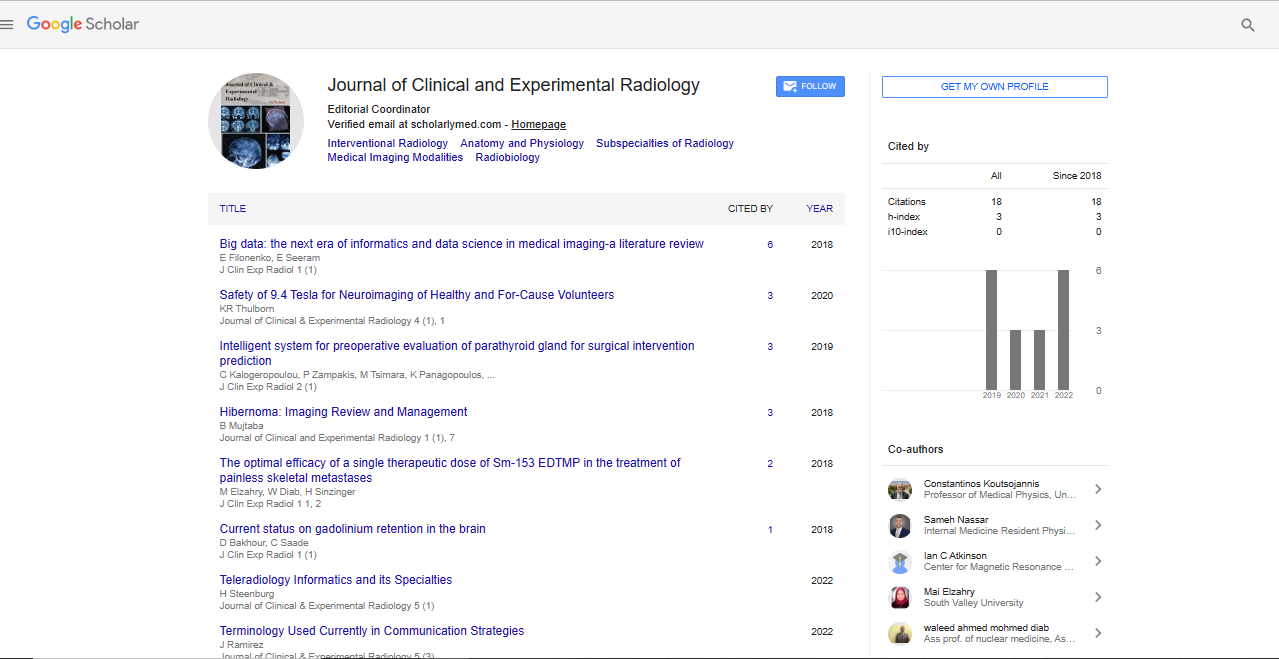Perspective, J Clin Exp Radiol Vol: 6 Issue: 2
Diagnostic Accuracy of Imaging Techniques in Breast Cancer
Tjaan Senna*
1Department of Medical Oncology, Maastricht University Medical Centre, Maastricht University, Maastricht, The Netherlands
*Corresponding Author: Tjaan Senna,
Department of Medical Oncology,
Maastricht University Medical Centre, Maastricht University, Maastricht, The
Netherlands
E-mail: tjaan@senna.edu
Received date: 28 May, 2023, Manuscript No. JCER-23-106678
Editor assigned date: 31 May 2023, Pre QC No. JCER-23-106678 (PQ);
Reviewed date: 14 June, 2023, QC No. JCER-23-106678
Revised date: 22 June, 2023, Manuscript No. JCER-23-106678 (R);
Published date: 28 June, 2023, DOI: 07.4172/jcer.1000138
Citation: Senna T (2023) Diagnostic Accuracy of Imaging Techniques in Breast Cancer. J Clin Exp Radiol 6:2.
Description
Breast cancer is a significant global health concern, and early detection plays an essential role in improving patient outcomes. Imaging techniques are essential tools in the diagnosis and management of breast cancer. They aid in the detection, characterization, and staging of breast lesions. This study aims to discuss the diagnostic accuracy of various imaging techniques commonly used in breast cancer, including mammography, ultrasound, Magnetic Resonance Imaging (MRI), and molecular imaging modalities. Mammography is the gold standard imaging technique for breast cancer screening and detection. It utilizes low-dose X-rays to produce detailed images of the breast tissue. Mammography is highly sensitive in detecting micro calcifications and architectural distortions associated with early breast cancer. It also plays a vital role in identifying suspicious masses. Digital mammography has replaced film-screen mammography and offers improved image quality, allowing for better visualization of breast abnormalities. Additionally, advancements in mammographic technology, such as Digital Breast Tom Synthesis (DBT), have further enhanced the diagnostic accuracy by providing three-dimensional images of the breast, reducing overlapping tissue artifacts, and improving lesion detection.
Breast ultrasound is commonly used as an adjunct imaging modality to mammography. It utilizes sound waves to provide realtime images of the breast tissue. Ultrasound is particularly useful in characterizing breast masses detected on mammography and assessing the vascularity of the lesions. It can differentiate between solid masses and fluid-filled cysts, aiding in the determination of the need for further evaluation. Ultrasound-guided biopsy can be performed to obtain tissue samples for definitive diagnosis. Recent advancements, such as the use of elastography and contrast-enhanced ultrasound, have improved the diagnostic accuracy of breast ultrasound by assessing tissue stiffness and enhancing lesion vascularity. MRI plays a vital role in breast cancer diagnosis and staging, especially in highrisk individuals and patients with inconclusive mammography or ultrasound findings. It provides detailed images of breast tissue using magnetic fields and radio waves. Breast MRI has high sensitivity in detecting breast cancer, particularly invasive cancers. It is useful for evaluating the extent of disease, assessing tumor size, identifying multi centric or multifocal disease, and evaluating the response to neoadjuvant chemotherapy. Dynamic Contrast-Enhanced MRI (DCEMRI) with the administration of intravenous contrast agents improves lesion detection and characterization by evaluating the vascularity and enhancing abnormal tissue areas.
Molecular imaging techniques, such as Positron Emission Tomography (PET) and Molecular Breast Imaging (MBI), offer valuable information about the biological characteristics of breast lesions. PET utilizes radiotracers that target specific metabolic processes to detect areas of increased metabolic activity. It is useful in identifying distant metastases, assessing treatment response, and detecting recurrent disease. MBI uses a gamma camera and a radiotracer to image the breast tissue, particularly in patients with dense breasts or those at high risk for breast cancer. It improves lesion detection in women with dense breast tissue and has shown in detecting small tumors.
The diagnostic accuracy of each imaging modality varies depending on factors such as breast density, lesion characteristics, and patient factors. Mammography remains the primary screening tool for breast cancer, providing high sensitivity in detecting calcifications and masses. Ultrasound is valuable in further characterizing lesions identified on mammography and distinguishing between cystic and solid masses. MRI is highly sensitive for invasive breast cancer detection and is particularly useful in high-risk populations. Molecular imaging modalities, such as PET and MBI, offer functional and molecular information about breast lesions but are typically used in specific clinical scenarios.
Imaging techniques play an essential role in the diagnosis and management of breast cancer. Mammography, ultrasound, MRI, and molecular imaging modalities offer complementary information and have varying diagnostic accuracies depending on the clinical context. A multimodality approach, including mammography as the primary screening tool, can improve the detection of breast cancer. Advances in imaging technology, such as digital breast tom synthesis, elastography, contrast-enhanced imaging, and molecular imaging agents, continue to enhance diagnostic accuracy and guide treatment decisions. Understanding the strengths and limitations of each imaging modality is essential in achieving optimal patient outcomes in breast cancer diagnosis and management.
 Spanish
Spanish  Chinese
Chinese  Russian
Russian  German
German  French
French  Japanese
Japanese  Portuguese
Portuguese  Hindi
Hindi 